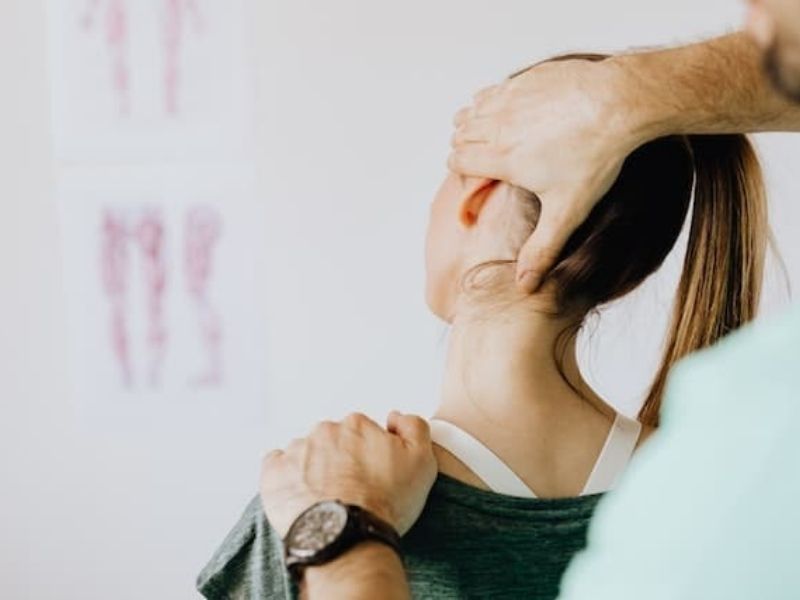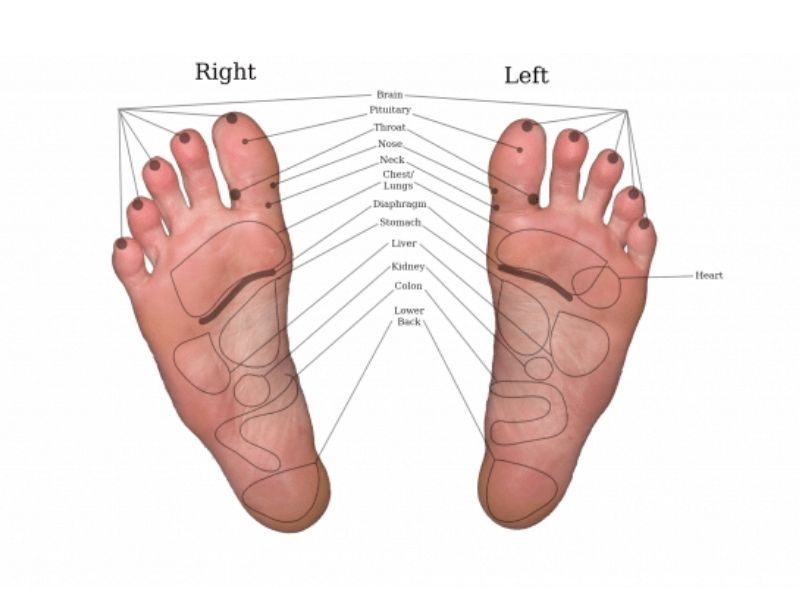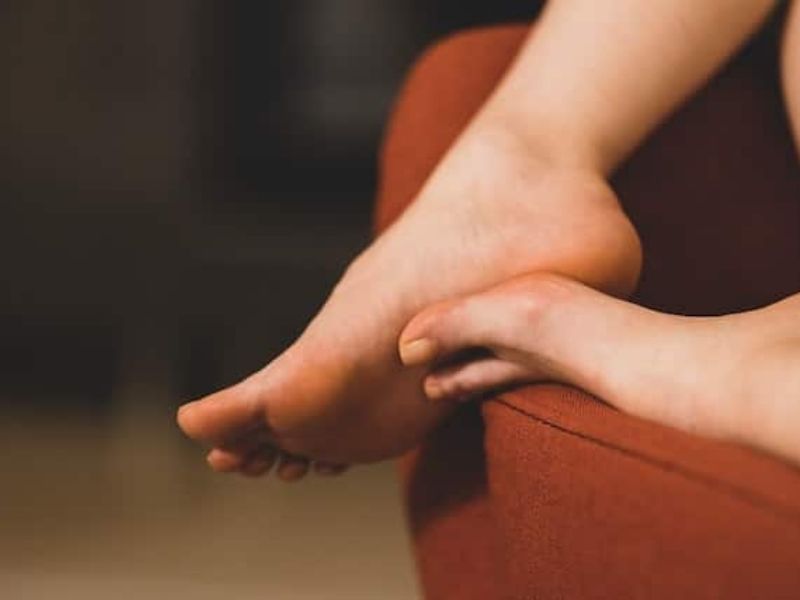Levator Scapulae Release: Resolve Trigger Points + Strengthen

The levator scapulae is a small but powerful muscle located on either side of your neck that connects your upper spine to your shoulder blade.
It helps control movement between these two areas as well as providing stability when you’re performing activities such as lifting or carrying weights.
When this muscle becomes tense, it can cause discomfort and restrict movement, leading to tightness in other muscles around it, which can result in pain throughout the upper body.
Fortunately, there are ways to resolve this issue by targeting specific trigger points within the muscle itself and then supplementing that with stretching and strength training exercises designed specifically for the area.
By combining both approaches, you’ll be able to create lasting relief from muscular aches and pains while also helping improve posture and overall mobility.
So let’s dive into what needs to be done so you can free yourself from pain and tension in this muscle.
[lwptoc]

Causes Of Neck Pain
Neck pain is a common issue that can have many causes. From injury to habitual overuse and fatigue, it’s important to identify the source of your discomfort and take steps to neck pain relief.
One area that may be contributing to neck pain is the levator scapulae muscle. It’s located in the upper back and can be a source of painful tension when short and tight muscles, or trigger points, develop.
Trigger points are tender spots in muscles that create localized pain and can refer to other areas such as down the arm or up toward the head.
The scalene muscles, which run along both sides of the neck, also contribute to shoulder pain and work alongside the powerful sternocleidomastoid.
Combined with the commonly known upper trapezius, these three muscles support our arms while they reach forward and aid in breathing by lifting our ribs during inhalation.
When tightened, they pull on the vertebrae of our spine, causing tension in surrounding muscles like the levator scapulae and creating even more discomfort.
If you want to prevent future neck pain, here is what you can do:
- Gently stretching these muscles regularly will help alleviate some of this built-up tension and improve overall mobility in your neck region.
- Proper muscle conditioning involves:
- Engaging core stabilizers instead of relying solely on external musculature for stability;
- Learning how to breathe correctly using diaphragmatic breathing
- Understanding ergonomics at work, home, or driving
- Integrating a basic range of motion activity throughout daily life plays an integral role in maintaining a healthy balance within the body’s neuromuscular system.
Taking time each day for self-care practices helps ensure you stay free from chronic pains caused by imbalances related to lifestyle choices we make over time!
What Causes A Tight Levator Scapulae?
Have you ever tried to keep a balloon in the air for too long? Eventually, it becomes heavy and starts to fall. This is similar to what happens when our levator scapulae muscles become tight.
The constant strain of holding your shoulders up causes fatigue and tension that can lead to trigger points and increased nerve sensitivity.
The primary cause of tightness in the levator scapulae muscle is likely postural strain combined with prolonged sitting or standing without breaks.
The combination of these two factors creates an environment where your shoulder blades are held in a position that puts excessive work on the levator scapula muscles.
Excessive forward head posture is another feature associated with rounded shoulders and can contribute to a painful neck in some people.
This forward head posture position alters the mechanics of the cervical spine and can further exacerbate muscle fatigue and trigger point development in stabilizing muscles.

If a lack of physical conditioning is also present, the levator scap has even less ability to cope with the demand.
So, what makes the levator scapulae tight? Let’s summarize them below:
- Working at a computer with the head turned
- Emotional/mental stress
- Carrying heavy bags with a shoulder strap
- Chilling of the muscle during sleep from a ceiling fan or air conditioner
- Holding a phone between the shoulder and ear for too long
- Sleeping on your stomach with your head turned
- Head forward posture
- Cervical spine dysfunction.
- Repetitive arm motions such as in swimming, throwing, or racquet sports.
To prevent or resolve trigger points and tightness in the levator scapulae, we must focus on strengthening the area while also addressing underlying postural issues such as hunching over a desk or computer all day long, at least until we can build up enough strength and endurance to tolerate these habitual positions.
Achieving proper alignment through conscious body awareness will also ensure that there’s no unnecessary strain placed on any one particular muscle group resulting from sub-optimal posture habits, something that often goes unrecognized but plays a major role in overall neck health.
Being mindful about how much time you spend sitting or standing each day, coupled with regular stretching, strength training, and improved body mechanics, will go a long way toward keeping the levator scapulae healthy and free from pain-causing trigger points!
This brings us to our next section: relieving the pain in your neck.
How Do You Relieve Levator Scapulae Neck Pain?
It’s been theorized that many cases of neck pain stem from trigger points in the levator scapulae. But is this true? Let’s investigate it further.
The Levator Scapulae is a muscle located between your shoulder blade and the back of your neck, so any tension or tightness can cause serious discomfort in the area.
To relieve levator scapulae-induced neck pain, you need to both release those trigger points and strengthen the surrounding muscles for long-term relief.
To start releasing these trigger points, try using massage balls or foam rollers on the affected area. This will help loosen up any knots and get rid of built-up lactic acid, which causes stiffness.
You should also stretch out the area to increase flexibility and range of motion in order to reduce chronic pain. Some popular stretches include chin tucks, side bends with rotation, and forward folds over a chair or bench.
Wall Angels
To perform wall angels, stand with your back against a wall and your feet about 6 inches away. Raise your arms to shoulder height, with your elbows bent and your forearms resting against the wall. Slowly slide your arms up the wall, keeping your elbows and forearms in contact with the wall. Hold for a few seconds at the top, then slowly lower back down.
Band Pull Aparts
To perform band pull aparts, hold a resistance band with both hands, with your hands shoulder-width apart. Begin with your arms extended straight in front of you, then pull the band apart towards your chest, squeezing your shoulder blades together. Slowly release back to the starting position and repeat for 10-15 repetitions.
Both are designed to target specific areas such as rotator cuff muscles while engaging other important muscles like rhomboids and trapezius too!
These moves require attention to form, so make sure you use proper technique when executing them—if not done correctly, they could do more harm than good!
Additionally, incorporating an overall strength program into your daily routine can be beneficial for improving posture, balance, and stability, which all impact how we feel throughout our day-to-day lives.
No matter what type of treatment plan you decide upon—whether it’s targeted releases, stretches, or exercise—just remember that consistency is key to achieving lasting results!
Sticking with your chosen course of action will ensure that you see positive changes over time, gradually increasing intensity as needed until desired goals are achieved.
With patience comes progress; take care of yourself today and reap rewards tomorrow!
Should You Stretch Your Neck Muscles?
Stretching your neck muscles can help reduce levator scapulae trigger points and pain and loosen a stiff neck.
Increased muscle tension over time can become subconscious, and you may find yourself walking around holding your neck muscles tight during activities in which it doesn’t make sense to do so.
This is particularly common in the trapezius muscle, often referred to as the “stress muscles.”
However, it’s important to avoid overstretching or putting too much pressure on the neck muscles, as this can cause pain and injury.
It’s also important to avoid stretching the neck if you have any underlying medical conditions, such as herniated discs or spinal stenosis without consulting your doctor first.
How To Stretch The Levator Scapulae
There are several different stretches that target these muscles, but they should be done carefully with proper form, as the incorrect technique could cause injury instead of improving mobility.
Let’s look at some of the levator scapulae stretches in detail:
#1. Shoulder Rolls: Sit up straight with your feet flat on the floor. Lift your shoulders up towards your ears and then roll them back and down. Repeat this movement 10–15 times.
#2. Neck Stretch: Sit up straight and look straight ahead. Slowly lower your right ear towards your right shoulder until you feel a stretch in the left side of your neck. Hold for 10–15 seconds, and then repeat on the other side.
#3. Chin Tuck: Sit up straight and look straight ahead. Tuck your chin in towards your chest without moving your shoulders or tilting your head. Hold for 5–10 seconds, and then relax.
#4. Levator Scapulae Stretch: Sit up straight and look straight ahead. Reach your right hand behind your back and place it on your left shoulder blade. Use your left hand to gently pull your head towards your left shoulder until you feel a stretch in the right side of your neck. Hold for 10–15 seconds, and then repeat on the other side.
#5. Upper Trapezius Stretch: Sit up straight and look straight ahead. Reach your right arm over your head and place your hand on your left ear. Use your left hand to gently pull your head towards your left shoulder until you feel a stretch in the right side of your neck. Hold for 10–15 seconds, and then repeat on the other side.
#6. Foam Roller Stretch: Lie on your back with a foam roller under your upper back. Slowly roll the foam roller towards your shoulders until it reaches the top of your shoulder blades. Hold for 10–15 seconds, and then slowly roll back down.
These simple tips, combined with regular massage therapy sessions and adequate rest periods throughout training cycles, can allow individuals suffering from tightness in the levator scapulae region to experience relief without compromising their fitness goals or risking further injury through aggressive stretching techniques.
Levator Scapulae: Self-Massage
Self-massage can be a helpful way to relieve tension in the levator scapulae muscle. Here’s how to perform a self-massage for this muscle:
- Locate the Levator Scapulae: The levator scapulae muscle is located on the side of the neck, between the top of the shoulder blade and the base of the skull.
- Use Your Fingers: Place the fingertips of one hand on the side of your neck, just above the collarbone and below the ear. Apply gentle pressure and move your fingers slowly up toward the base of your skull until you feel a tender spot.
- Apply Pressure: Apply pressure to the tender spot with your fingertips and hold for 10-15 seconds. As you apply pressure, try to relax the muscle.
- Massage: While maintaining pressure, use a circular or back-and-forth motion to massage the muscle. Continue for 30-60 seconds.
- Repeat on the Other Side: Repeat the massage on the other side of your neck.
You can perform this self-massage as often as needed, depending on the level of tension and discomfort you experience.
Conclusion
The levator scapulae is a vital neck muscle and could be more painful when it’s tight. This pain is common and is caused by muscles becoming overused or strained due to poor posture or repetitive movements.
Fortunately, there are several things you can do to help relieve the tension in your levator scapulae and get yourself feeling better in no time!
Here is what can help you relieve the tension: Stretch out the area around your shoulder blades and upper back while trying self-massage techniques.
Strengthening exercises will also be key to helping resolve any issue with your levator scapula. I recommend focusing on postural strengthening exercises such as planks and chin tucks; these will help improve alignment and reduce strain on the muscles around your neck and shoulders.
If you’re struggling with chronic pain from your levator scapulae, don’t give up hope! With proper care, attention, and dedication, you’ll soon be able to find relief from this common source of discomfort.
By combining targeted stretches, massage therapy, and strength-building exercises into your regular routine, you’ll be amazed at how quickly you see results! So go ahead—give it a try today; you won’t regret it!
Sam Visnic
I’ve spent my life studying the fundamental aspects of human health with a focus on movement and clinical massage therapy. In a world of specialists, surgical procedures, drugs and quick fix remedies, I’m committed to finding and developing strategies that help people stuck at the “gap”. Over the last 20 years I’ve studied dozens of systems and methodologies for uncovering the root cause of aches and pains, along with postural and movement issues. Pain science, the art and science of hands-on soft tissue massage techniques, myofascial release, and coaching movement is essential in my practice. Integrating different methods but above all deciphering WHEN to use different techniques with different people and situations, along with integration of movements that people want to be able to do again is the key to long term success with my incredible track record with clients. Understanding the various elements that contribute to conditions and the power of communication and education makes my Release Muscle Therapy program separate from other hands-on therapy approaches.
Blogs You May Be Interested In
Categories
-
Deep Gluteal Pain Syndrome
-
Deltoids
-
Fallbrook
-
Foam Rolling
-
Glutes
-
Hamstrings
-
Hypnosis For Pain
-
Lats
-
Levator Scapulae
-
Lifestyle
-
Massage Therapy
-
Mobility
-
Movement and Exercise
-
Murrieta
-
Muscles
-
Nutrition
-
Obliques
-
Pain
-
Pectorals
-
Piriformis
-
Plantar Fasciitis
-
Product Review
-
Psoas
-
Quadratus Lumborum
-
Quadriceps
-
Rhomboids
-
Serratus Anterior
-
SI Joint
-
Sternocleidomastoid
-
Stretching
-
Subscapularis
-
Temecula
-
TMJ
-
Trapezius
-
Uncategorized
















